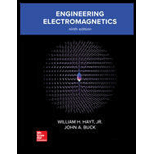
Concept explainers
(a)
The
Answer to Problem 14.3P
The value of electric field is
Explanation of Solution
Given:
The following parameters are given:
Concept Used:
This point lies along the axis of the antenna in the
Calculation:
Using the given values, the electric field
Conclusion:
The value of electric field is
(b)
The
Answer to Problem 14.3P
The value of electric field is
Explanation of Solution
Given:
The following parameters are given:
Concept Used:
This point lies along the axis of the antenna in the
Calculation:
Using the given values, the electric field
Conclusion:
The value of electric field is
(c)
The value of
Answer to Problem 14.3P
The value of electric field is,
Explanation of Solution
Given:
The following parameters are given:
Concept Used:
This point lies along the x direction, contribution from both the antenna will be counted. Since the distance is same, the result obtained from part (a) and (b) needs to be added.
Calculation:
Under this given condition, the electric field
Conclusion:
The value of electric field is
(d)
The value of
Answer to Problem 14.3P
The value of electric field is
Explanation of Solution
Given:
The following parameters are given:
Concept Used:
At any time t, the electric field
Calculation:
Using the result obtained in the previous section,
For
Conclusion:
The value of electric field is,
(e)
The value of
Answer to Problem 14.3P
The value of magnitude of electric field is
Explanation of Solution
Given:
The following parameters are given:
Concept Used:
At any time t, the electric field
Calculation:
The magnitude of part (d) result is,
Conclusion:
The value of magnitude of electric field is,
Want to see more full solutions like this?
Chapter 14 Solutions
Engineering Electromagnetics
- Find the valve of V using the Thevenin Equivalent Circuit and then determine if the 8 ohm resistor allows maximum power transfer. If not, then what value should the 8 ohm resistor be changed to for maximum power transfer? ZA 6 6 + 22V 83 V 34 2 6 АААА ААААarrow_forwardFind the valve of voltage Vx using the THE VIN IN equivalent circuit ww 8 Show the Theven in Circuit. I 7V ZV m 6 5 M + 4 34 АА 3 1 АААА 9A ↑ 24arrow_forwardDon't use ai to answer I will report you answerarrow_forward
- A speech signal has frequencies in the range 50- 3500 Hz. The signal is sampled at Nyquist sampling rate and the resulting pulses are transmitted over PAM and PCM systems. 1- Calculate the minimum bandwidth of the PAM system. 2- Calculate the minimum bandwidth of the PCM system, when the pulses are quantized into 121 levels B) Draw the signaling waveform (line codes) for the binary sequence 10110001 using (Unipolar NRZ, Bipolar RZ, Bipolar NRZ, Manchester code, Differential Manchester (split phase).arrow_forwardDon't use ai to answer I will report you answerarrow_forwardDon't use ai to answer I will report you answerarrow_forward
 Introductory Circuit Analysis (13th Edition)Electrical EngineeringISBN:9780133923605Author:Robert L. BoylestadPublisher:PEARSON
Introductory Circuit Analysis (13th Edition)Electrical EngineeringISBN:9780133923605Author:Robert L. BoylestadPublisher:PEARSON Delmar's Standard Textbook Of ElectricityElectrical EngineeringISBN:9781337900348Author:Stephen L. HermanPublisher:Cengage Learning
Delmar's Standard Textbook Of ElectricityElectrical EngineeringISBN:9781337900348Author:Stephen L. HermanPublisher:Cengage Learning Programmable Logic ControllersElectrical EngineeringISBN:9780073373843Author:Frank D. PetruzellaPublisher:McGraw-Hill Education
Programmable Logic ControllersElectrical EngineeringISBN:9780073373843Author:Frank D. PetruzellaPublisher:McGraw-Hill Education Fundamentals of Electric CircuitsElectrical EngineeringISBN:9780078028229Author:Charles K Alexander, Matthew SadikuPublisher:McGraw-Hill Education
Fundamentals of Electric CircuitsElectrical EngineeringISBN:9780078028229Author:Charles K Alexander, Matthew SadikuPublisher:McGraw-Hill Education Electric Circuits. (11th Edition)Electrical EngineeringISBN:9780134746968Author:James W. Nilsson, Susan RiedelPublisher:PEARSON
Electric Circuits. (11th Edition)Electrical EngineeringISBN:9780134746968Author:James W. Nilsson, Susan RiedelPublisher:PEARSON Engineering ElectromagneticsElectrical EngineeringISBN:9780078028151Author:Hayt, William H. (william Hart), Jr, BUCK, John A.Publisher:Mcgraw-hill Education,
Engineering ElectromagneticsElectrical EngineeringISBN:9780078028151Author:Hayt, William H. (william Hart), Jr, BUCK, John A.Publisher:Mcgraw-hill Education,





